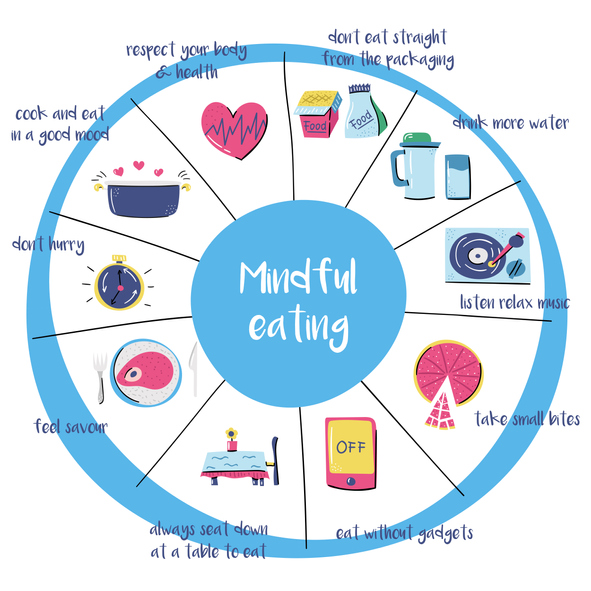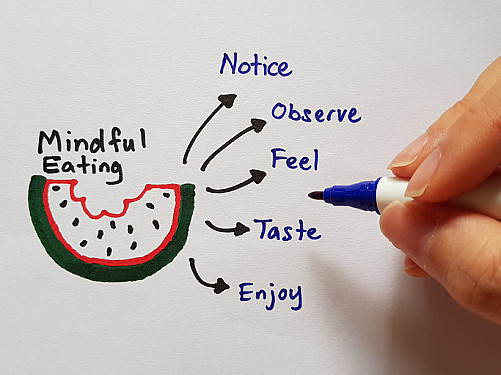In the fast-paced world we live in, the way we approach food has a significant impact on our overall well-being. With the rise of various diets and weight loss trends, it’s easy to overlook the simple yet powerful practice of mindful eating. In this comprehensive guide, we’ll delve into the principles of mindful eating and explore how it can become your ally in achieving and maintaining a healthy weight.
Understanding Mindful Eating
What is Mindful Eating?
Mindful eating is more than just a buzzword; it’s a way of approaching meals with awareness, attention, and intention. It involves being fully present during the eating experience, savoring each bite, and acknowledging the sensations, thoughts, and emotions that arise.
The Importance of Presence
At its core, mindful eating is about being present in the moment. It invites us to slow down, engage with our meals, and cultivate a deeper connection with the food we consume.
Breaking Free from Auto-Pilot
In our busy lives, it’s easy to slip into autopilot mode during meals. Mindful eating encourages us to break free from this pattern, fostering a conscious relationship with the act of nourishing our bodies.
The Basics of Mindful Eating

Savouring the Moment: Eating with Awareness
The journey into mindful eating begins with the simple act of being fully present during meals. Let’s explore how awareness transforms the way we eat.
Engaging the Senses
Eating is a multisensory experience. From the vibrant colors of fresh produce to the aroma of a well-cooked meal, engaging all your senses enhances the pleasure of eating.
Mindful Bites
Each bite is an opportunity to savor flavors, textures, and temperatures. By paying attention to the details, you not only enjoy your food more but also become more attuned to your body’s signals.
Building Mindful Habits

Cultivating Gratitude Through Food
Gratitude has the power to transform meals from a routine into a celebration. Let’s explore how expressing gratitude for your food can positively impact your eating habits.
The Ripple Effect of Gratitude
Cultivating gratitude extends beyond the plate. It influences your relationship with the people who contribute to your meals and the environment that provides the nourishment.
Mindful Eating Journal
Keeping a mindful eating journal can be a valuable tool. Documenting your meals, feelings, and observations creates self-awareness and helps you identify patterns.
Portion Control with Mindfulness
Mindful eating naturally guides you toward healthier portion sizes. Let’s delve into the art of portion control and how it aligns with mindful practices.
Listening to Your Body
Recognizing hunger and fullness cues is crucial. By tuning in to your body’s signals, you develop a more intuitive understanding of when to start and stop eating.
Quality Over Quantity
Mindful eating shifts the focus from quantity to quality. It encourages you to choose nutrient-dense foods that nourish your body, promoting overall well-being.
Mindful Practices Beyond the Plate
Recognizing Emotional Triggers
Our relationship with food is often intertwined with emotions. Let’s explore how mindful eating can help you recognize and navigate emotional triggers.
Emotional Awareness
Mindful eating encourages you to become aware of emotional cues that influence your food choices. By acknowledging emotions without judgment, you gain control over impulsive eating.
Mindful Pause
Before reaching for food in response to emotions, create a mindful pause. Take a few deep breaths, assess your feelings, and choose a response that aligns with your well-being.
Mindful Meal Planning: A Holistic Approach
Extend mindfulness to meal planning, creating a comprehensive strategy for balanced nutrition. Let’s explore how thoughtful meal planning contributes to mindful eating.
Conscious Choices
Mindful meal planning involves making conscious choices about the foods you bring into your home. Consider nutrient variety, freshness, and the overall nutritional profile of your meals.
Preparation as a Ritual
Transform meal preparation into a mindful ritual. Engage with the process, savoring the ingredients, and appreciating the effort that goes into creating nourishing meals.
Mindful Eating and the Body

The Mind-Body Connection
Explore the intricate relationship between the mind and body in the context of mindful eating. Understand how this connection influences your overall health and well-being.
Mindful Awareness and Digestion
Mindfulness during meals creates a relaxed state that positively influences digestion. Learn how being present enhances the absorption of nutrients and supports digestive processes.
Stress Reduction and Metabolism
Chronic stress can impact metabolism and contribute to weight gain. Discover how mindfulness practices reduce stress, promoting a healthier metabolic environment.
Overcoming Challenges in Mindful Eating
Dealing with Distractions
In a world filled with distractions, maintaining mindfulness during meals can be challenging. Let’s explore practical techniques to stay focused and present.
Technology-Free Zone
Designate mealtime as a technology-free zone. Put away devices, turn off the TV, and create an environment that encourages mindful eating without external disruptions.
Mindful Eating Exercises
Incorporate simple mindful eating exercises into your routine. These exercises, such as mindful breathing and mindful chewing, help anchor your attention to the present moment.
Patience and Persistence: Overcoming Mindless Habits
Developing mindful eating habits is a journey that requires patience and persistence. Let’s discuss strategies for overcoming common challenges and embedding mindfulness into your daily life.
Gradual Changes
Mindful eating is not about radical shifts overnight. Embrace small, gradual changes, allowing yourself the time to adapt and form lasting habits.
Mindful Reflection
Regularly reflect on your mindful eating journey. Celebrate successes, learn from challenges, and adjust your approach as needed. The key is persistence and a commitment to the process.
Mindful Eating in Everyday Life

Mindful Snacking: Making Every Bite Count
Extend mindfulness to snack time, turning it into an opportunity for conscious nourishment. Discover how mindful snacking contributes to overall well-being.
Purposeful Snacking
Rather than mindlessly reaching for snacks, approach snacking with purpose. Choose nutrient-rich options and savor each bite, enjoying the flavors and textures.
Mindful Snacking in Busy Moments
Even in hectic moments, mindful snacking is possible. Embrace quick, nutritious options, and take a moment to appreciate the nourishment they provide.
Mindful Eating in Social Settings
Navigate social occasions with grace by incorporating mindful principles into group dining experiences. Learn how to make healthy choices while enjoying the company of others.
Mindful Socializing
Engage in mindful conversations and be present with friends and family. Balancing socializing with conscious eating ensures you enjoy both the food and the company.
Making Mindful Choices
In social settings, make mindful choices without feeling restricted. Opt for balanced options, savor each bite, and appreciate the diverse flavors presented.
Conclusion: Nourishing Your Body and Mind
As we conclude this exploration of mindful eating, take a moment to reflect on the transformative power it holds. Mindful eating isn’t just about weight management; it’s about embracing a lifestyle that nourishes both your body and mind. By integrating mindfulness into your relationship with food, you embark on a journey towards lasting well-being.
Frequently Asked Questions (FAQs): Unveiling Clarity on Mindful Eating

What is mindful eating, and how does it differ from traditional eating habits?
Mindful eating involves being fully present during meals, savoring each bite, and acknowledging sensations, thoughts, and emotions. It differs from traditional eating habits by emphasizing awareness, intention, and a deeper connection with food.
Can mindful eating help with weight loss?
Yes, mindful eating can contribute to weight management by promoting healthier eating habits, fostering a more intuitive understanding of hunger and fullness, and reducing impulsive eating.
How can one incorporate mindfulness into meal planning and preparation?
Incorporate mindfulness into meal planning by making conscious choices about nutrient variety, freshness, and overall nutritional profiles. Turn meal preparation into a mindful ritual by engaging with the process and appreciating the effort behind creating nourishing meals.
Is mindful eating suitable for everyone?
Yes, mindful eating is inclusive and adaptable to various lifestyles. It encourages individuals to approach eating with awareness, regardless of dietary preferences or restrictions.
Can mindful eating be practiced in fast-paced, busy lifestyles?
Absolutely. Mindful eating can be adapted to busy schedules by incorporating simple practices like creating a technology-free mealtime, incorporating mindful eating exercises, and making purposeful snack choices even in hectic moments. The key is to infuse moments of mindfulness into your daily routine.

